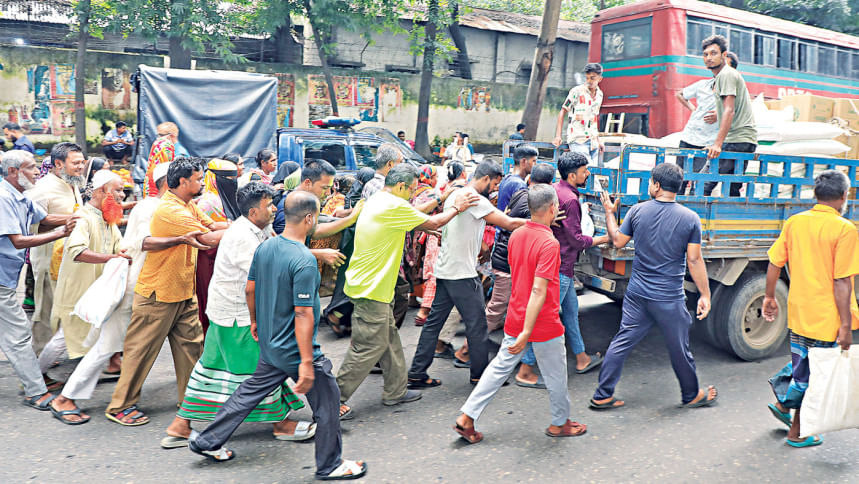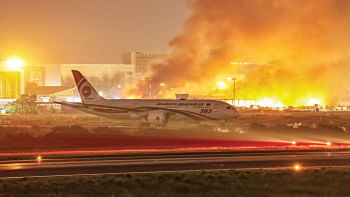Invest more in education, healthcare to end poverty

In the village of Kuralia, under Sirajganj Sadar upazila, about 125 kilometres northwest of Dhaka, Moklesur Rahman once earned a living as a handloom weaver.
With the advent of power looms, the age-old traditional handlooms that sustained his family for generations began to lose out.
Left with few options, he gave up weaving and turned to driving a battery-run rickshaw van for hire to provide for his seven-member family. Four of his five children now attend school, from grades one through ten, keeping alive dreams his parents could not fulfil.
"I don't want them to live the way I do," says the 43-year-old artisan, who never made it past secondary school.
"I had to stop dreaming early," he adds softly, "but I want them to keep dreaming."
While Moklesur's story is one of persistence, others, like that of Al Mahmud, reveal how struggling families can be pushed into the depths of poverty by a single health crisis.
Mahmud, a carpenter from Sirajganj, is currently receiving treatment at Shaheed Monsur Ali Medical College Hospital for a diabetic foot ulcer.
"I have already spent nearly Tk 50,000 on surgery and medical tests. Of that, I had to borrow Tk 40,000 from my relatives," he said.
"Although I didn't need to undergo surgery, I had to visit Khwaja Yunus Ali Medical College, a private hospital about 31 kilometres away, several times for lab tests. Each test costs nearly Tk 5,000," he told The Daily Star.
"Now I'm going through a hard time. I don't know how I will manage in the future," said Mahmud, a father of three.
Mahmud's ordeal reflects a grim reality for millions.
Out-of-pocket (OOP) expenditure accounts for nearly 73 percent of Bangladesh's total healthcare spending—the highest in South Asia. Such costs often drive low-income families into debt, forcing them to sell assets or borrow money to pay for medical treatment.
Like Moklesur and Mahmud, thousands of families across the country continue to bear the dual burden of intergenerational poverty and rising OOP expenses, often aggravated by institutional neglect and limited access to affordable healthcare.
Amid these struggles, Bangladesh today observes the International Day for the Eradication of Poverty, under the theme "Ending Social and Institutional Maltreatment: Ensuring Respect and Effective Support for Families Living in Poverty."
The observance comes at a time when poverty, which had been declining for decades, is showing signs of resurgence amid persistently high inflation, low job growth, and limited social protection coverage.
For families like Moklesur's and Mahmud's, poverty is no longer just a lack of income—it is a cycle reinforced by unequal access to opportunities, healthcare, and institutional support.
According to the local think tank Power and Participation Research Centre (PPRC), poverty in Bangladesh has surged over the past three years, with nearly 28 percent of the population now poor, compared to 18.7 percent in 2022.
The share of people in extreme poverty has risen to 9.35 percent this year, up from 5.6 percent three years ago.
Now, one in four people lives below the poverty line, and one in ten is in extreme poverty. Another 18 percent are considered "vulnerable non-poor," at risk of falling into poverty.
The World Bank's Poverty and Equity Briefs for October warned that extreme poverty might rise to 8.9 percent, adding 12 lakh more to the poor.
"Inequality is also expected to widen, with the Gini index increasing by 0.2 percentage point, potentially affecting the nation's ability to achieve middle-income status by 2026," the WB noted.
"Poverty reduction is not a one-step process; it cannot be achieved through a single dimension," said Hossain Zillur Rahman, executive chairman of the PPRC.
He explained that poverty itself is diverse.
"The poor are not a homogeneous group; there are rural poor, urban poor, and marginalised communities. Even within poverty, there are layers," he said.
"Those living just above the poverty line can make some progress, but those in extreme poverty remain trapped much deeper," added the economist.
"Among them, female-headed households now face a very distinct type of problem," he said.
He warned that neglecting health and education can worsen intergenerational poverty.
"If we fail to ensure access to education and healthcare, poverty will persist across generations," said the academic.
"The current generation may be poor, but at least the next should have a chance to move up. Without public support, that hope won't materialise," said Zillur Rahman.
Citing government spending, he said, "The government invests heavily elsewhere, but health and education lack urgency. The problem isn't just low budgets but also ineffective use—an institutional reform issue."
"Bureaucratic, political, and policy actors aren't giving these sectors serious attention, creating barriers that trap the next generation in poverty," he said.
Agreeing that poverty is a vicious cycle, the economist said, "We once started breaking it, but new crises keep emerging, and our plans need redesigning."
He added that policies often overlook basic needs. "Most housing policies target those who can afford 5,000 square feet. That shows who we're really planning for," he said.
"Affordable housing, primary healthcare, quality basic education, and public transport—these are the four areas that matter most," said Zillur Rahman, also a policymaker.
"If you look at these—affordable public transport, affordable housing, accessible primary healthcare, and quality basic education up to class eight—these four are fundamental," he said.
"But in none of these four areas do we have real policy priority," he said.
"These four are actually the biggest institutional barriers. Unless we address them, the institutional obstacles will remain, and people will continue to be trapped in poverty," said Zillur Rahman.
Referring to the structural nature of poverty, he said, "We used to understand poverty mainly as an issue of low income. But now, structural problems have entered the picture."
"If we want to reduce poverty, it cannot be done only through targeted programmes. There must be overall dynamism in the economy," he said.
Employment and livelihood opportunities are central to this. Unless the broader economy grows, poverty cannot be reduced merely through social safety nets, he said.
Rahman described poverty as a constant struggle between income and expenses, saying that managing this balance is key to escaping poverty.
He warned that inflation, driven not just by policy but also by the concentration of market power in sectors like housing, is a major barrier.
Calling for pro-poor growth, he noted that while Bangladesh's economy has grown impressively over the past 15 years, it has not necessarily benefited the poor.
Mustafa K Mujeri, executive director of the Institute for Inclusive Finance and Development (InM), echoed concerns about intergenerational poverty.
"Children of poor parents often remain poor due to a lack of quality education and healthcare. Without investment, they end up in child labour or low-skilled work, continuing the cycle for decades," he said.
"To break this cycle, we must create opportunities, jobs, education, and markets, and build the capabilities of the poor to seize them," he added.
"Good jobs exist, but the poor often lack access, leaving many trapped in low-paid, hand-to-mouth work," said Mujeri.
He stressed that true poverty reduction requires more than survival—improving income, skills, savings, and access to credit enables the poor to earn more, build assets, and even start small businesses.
"Without coordinated support across employment, savings, credit, and capacity building, poverty cannot be alleviated," he warned.

 For all latest news, follow The Daily Star's Google News channel.
For all latest news, follow The Daily Star's Google News channel. 



Comments